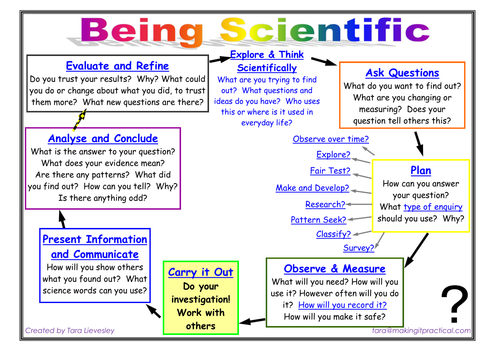


This fully EDITABLE resource is for teachers as a teaching tool, but also as a self-assessment support type tool for students, when teaching science. In the Word form it can be used to print out cards for the students, in particular the second page which can be blown up to A3 for groups of students to plan their ideas, or as the PowerPoint it can run on the whiteboard to aid teaching. You can also download this resource as a PDF document from the TES website (cheaper!).
SO WHAT DOES IT DO?
When teaching science, it is the skills and the thinking scientifically that make a scientist, not the knowledge or facts that are gained. This resources (part of a set on ‘Being Scientific’) helps to not only identify the skills, but to support progression within each individual skill area, helping create more confident and competent scientists in the classroom. Although it fits well with the NC for England, because it is based on thinking skills, child development and Bloom's taxonomy, it simply good practice and can be used in a variety of contexts and countries.
WHAT’S IN IT?
The first slide in each section of the resource has the Being Scientific Cycle included: what could be called the 'Enquiry Cycle' of asking questions, deciding on an approach to answer the question, presenting what was discovered and then asking further questions. This is in essence what science is all about: asking questions and finding answers, then asking more questions!
What follows is a ‘child friendly’ progressive set of support cards with initially simple cloze procedures, through to some key questions to consider for the skill being focussed on, helping students progress from the beginning of primary school through to early secondary years. This skill in this set is focussed on:
Learning how to ask Questions that are Testable, rather than just 'questions'.
WHAT ARE THE BENEFITS?
When planning lessons, focussing on an individual skill, in order to develop it further allows students to have more time to consider the WAGOLLs (What A Good One Looks Like) and how to refine this, without having to write everything for the whole investigation. This means that the students should only be writing up the skill being assessed. The rest of the process can be recorded in other ways such as photographs, listening to discussions, using floor books, etc. Obviously this also means more focussed marking (and less of it!)
This resource is also available as a PDF document (from the TES website), which is priced cheaper. Contact me if you have any questions or to find out about other resources: tara@makingitpractical.com
SO WHAT DOES IT DO?
When teaching science, it is the skills and the thinking scientifically that make a scientist, not the knowledge or facts that are gained. This resources (part of a set on ‘Being Scientific’) helps to not only identify the skills, but to support progression within each individual skill area, helping create more confident and competent scientists in the classroom. Although it fits well with the NC for England, because it is based on thinking skills, child development and Bloom's taxonomy, it simply good practice and can be used in a variety of contexts and countries.
WHAT’S IN IT?
The first slide in each section of the resource has the Being Scientific Cycle included: what could be called the 'Enquiry Cycle' of asking questions, deciding on an approach to answer the question, presenting what was discovered and then asking further questions. This is in essence what science is all about: asking questions and finding answers, then asking more questions!
What follows is a ‘child friendly’ progressive set of support cards with initially simple cloze procedures, through to some key questions to consider for the skill being focussed on, helping students progress from the beginning of primary school through to early secondary years. This skill in this set is focussed on:
Learning how to ask Questions that are Testable, rather than just 'questions'.
WHAT ARE THE BENEFITS?
When planning lessons, focussing on an individual skill, in order to develop it further allows students to have more time to consider the WAGOLLs (What A Good One Looks Like) and how to refine this, without having to write everything for the whole investigation. This means that the students should only be writing up the skill being assessed. The rest of the process can be recorded in other ways such as photographs, listening to discussions, using floor books, etc. Obviously this also means more focussed marking (and less of it!)
This resource is also available as a PDF document (from the TES website), which is priced cheaper. Contact me if you have any questions or to find out about other resources: tara@makingitpractical.com
Something went wrong, please try again later.
This resource hasn't been reviewed yet
To ensure quality for our reviews, only customers who have purchased this resource can review it
Report this resourceto let us know if it violates our terms and conditions.
Our customer service team will review your report and will be in touch.
£3.00